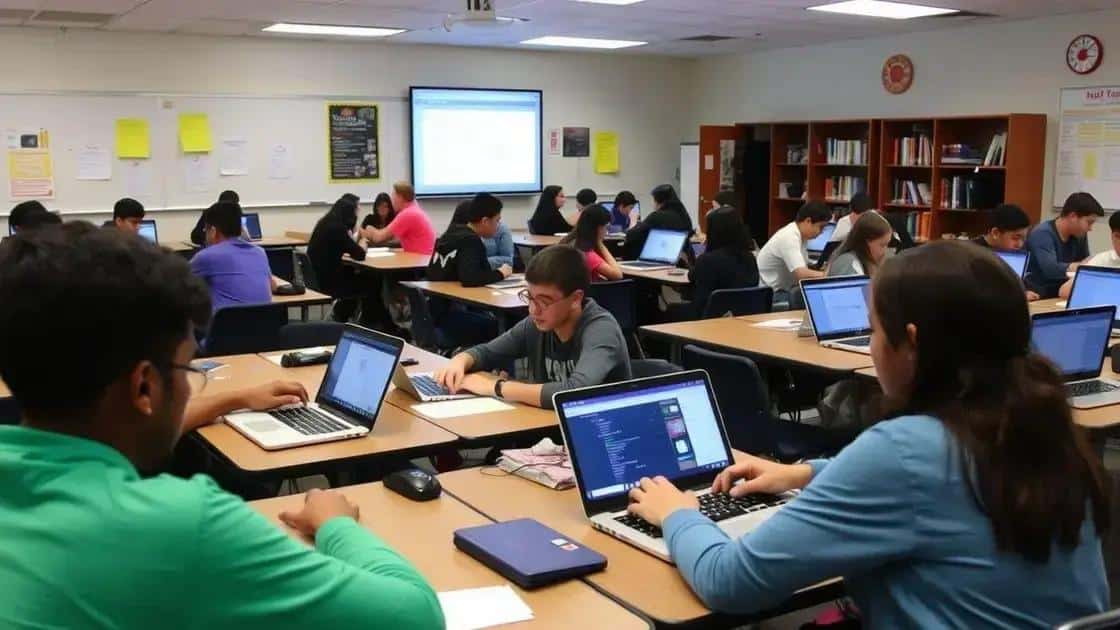Insights on high school coding classes: are they enough?

Insights on high school coding classes reveal their importance in equipping students with essential coding skills, promoting problem-solving abilities, and preparing them for a tech-centric future through interdisciplinary learning and collaborative projects.
In today’s digital age, insights on high school coding classes reveal their growing significance. Have you ever wondered how these classes shape the future of students in technology?
The importance of coding skills in the modern world
Understanding the importance of coding skills in the modern world is crucial for young learners. As technology evolves, coding has become a fundamental skill, similar to reading and writing. It empowers students to innovate and solve problems effectively.
Why Coding Skills Matter
In today’s job market, many employers seek candidates who can code. This skill opens doors to various career paths in fields like software development, data analysis, and engineering. Learning to code not only helps students gain technical expertise, but it also fosters critical thinking and creativity.
Key Benefits of Learning to Code
- Cultivates problem-solving skills
- Enhances job opportunities in tech
- Promotes logical thinking
- Encourages collaboration and teamwork
Moreover, as we rely more on technology, understanding the basics of programming can help students navigate the digital world safely. It prepares them for future challenges and equips them with tools to create their own projects.
As coding becomes integrated into various subjects, students can apply their skills in real-life scenarios. For example, a student can use coding to create a simple website, which reinforces their learning through hands-on experience. This practical application not only solidifies knowledge but also boosts confidence.
Ultimately, prioritizing coding education in high schools lays the foundation for a knowledgeable and adaptable workforce. Students who learn to code are better prepared for a world where technology is ever-present, making the importance of coding skills undeniable.
How high school coding classes are structured

Understanding how high school coding classes are structured is essential for both students and educators. These classes are designed to teach coding in an engaging way that fosters student interest and skill development.
Curriculum Overview
Typically, high school coding courses cover various programming languages, such as Python, Java, and JavaScript. Students learn the basics of coding, focusing on syntax, logic, and problem-solving. The classes often emphasize hands-on projects that allow students to apply what they’ve learned.
Class Activities
- Hands-on coding projects
- Collaborative group work
- Interactive coding challenges
- Use of coding platforms and tools
Students work on individual and group projects, creating everything from simple games to web applications. This practical approach enhances understanding and retention of coding concepts.
Many schools also incorporate online resources and coding platforms into their curriculum. These tools provide students with additional practice and help them learn at their own pace. By leveraging technology, classes can be more dynamic and engaging.
Furthermore, students are encouraged to participate in coding competitions and hackathons. This involvement not only boosts their skills but also cultivates teamwork and creativity. As they collaborate on coding challenges, they build connections with peers who share similar interests.
In essence, high school coding classes equip students with valuable skills for the future while providing an enjoyable and interactive learning experience. Through a blend of theory and practice, students emerge with a solid coding foundation that prepares them for further studies or careers in tech.
Challenges students face in coding education
Students today encounter various challenges in coding education. Identifying these obstacles is crucial for creating a supportive learning environment. Many students feel overwhelmed by the complexities of programming languages and concepts.
Common Challenges Faced
One significant issue is the steep learning curve associated with coding. Many students may struggle to grasp the fundamental concepts, leading to frustration and disengagement. Limited prior experience with technology can make it even more daunting.
Understanding and Motivation
- Lack of confidence in problem-solving skills
- Difficulty in understanding abstract coding concepts
- Challenges in applying theoretical knowledge in practical situations
- Limited resources for extra help
Moreover, motivation can wane if students do not see immediate results from their efforts. They might feel discouraged if they do not grasp a concept quickly or if coding tasks seem overly complicated. It’s essential for educators to provide encouragement and celebrate small victories.
Peer collaboration is another area that can present challenges. While working with classmates can be beneficial, it may also lead to competition or comparison, affecting some students’ confidence. Creating a team-oriented atmosphere can help alleviate these pressures.
Additionally, access to quality resources and support can vary significantly among schools. Some students may attend schools with excellent coding programs, while others may face limited availability of trained instructors or coding tools. This disparity can hinder their learning experience.
Ultimately, addressing these challenges requires a comprehensive approach. By fostering a positive and inclusive environment, teachers can help students overcome barriers in coding education.
Future trends in high school coding curriculums

The future trends in high school coding curriculums are set to transform how students learn about technology. As the world becomes more digital, education must adapt to keep pace. One significant trend is the increasing integration of coding across various subjects.
Interdisciplinary Approaches
Schools are starting to recognize that coding can enhance learning beyond computer science classes. For example, incorporating coding into math and science helps students apply their knowledge in practical ways. By blending subjects, students see the real-world applications of their skills, making learning more relevant.
Emphasis on Problem-Solving
- Focus on critical thinking and creative solutions
- Encouragement of collaboration through group projects
- Inclusion of real-world scenarios to tackle with coding
- Use of challenges and competitions to stimulate interest
Another trend is the emphasis on problem-solving skills. Educators are shifting from traditional teaching methods to project-based learning, where students work on actual problems. This approach not only enhances engagement but also prepares them for future careers.
Moreover, schools are beginning to implement coding boot camps as part of their curriculum. These intensive training programs allow students to learn coding in a short time frame, focusing on practical skills that are in high demand in the job market.
The use of online platforms and resources is also growing. Students can access various coding tutorials and tools at their own pace, fostering self-directed learning. This flexibility accommodates different learning styles and allows them to dive deeper into areas of interest.
In summary, as high school coding curriculums evolve, the focus will continue to shift towards interdisciplinary learning, problem-solving, and utilization of technology. This evolution ensures that students are better equipped for a tech-driven future.
FAQ – Frequently Asked Questions about High School Coding Classes
What skills do students learn in high school coding classes?
Students learn various programming languages, problem-solving skills, and how to apply coding concepts in real-world scenarios.
What challenges do students face in coding education?
Students often struggle with complex concepts, lack of confidence, and limited resources for additional help.
How can teamwork enhance coding education?
Collaborative projects encourage peer learning, improve problem-solving abilities, and make learning more engaging.
What are the future trends in coding curriculums?
Future trends include interdisciplinary approaches, practical skills training through coding boot camps, and increased use of online resources.






